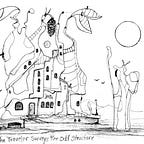How Strong Towns Principles Relate to Sioux Falls –Rational Responses
“Our cities now lack the resources to compensate for prediction mistakes. We can’t pretend to know the future and we’re too fragile to place huge bets on a specific outcome. We are like the primitive farmer knowing we need seven different plots but realizing we have only one. We’re going to have to innovate a new approach.” — Chuck Marohn
- based on “Strong Towns — A Bottom-Up Revolution To Rebuild American Prosperity” by Charles L. Marohn, Jr.
In the quote above, Marohn references a study of subsistence farmers in a remote corner of the world. Western researchers were appalled by the inefficiency of the local system. Farmers typically had about seven different plots of land in widely scattered areas. They spent a lot of time walking between their scattered plots. The researchers said if the farmers consolidated their plots into one location, they would be more efficient and could produce more food. But one researcher took the time to ask the farmers why they had their plots of land so widely scattered. The farmers said it was good to grow more food nine out of ten years by having the plots together but if you starved to death the 10th year, then it didn’t matter. The farmers had no safety net so this was the wisdom of those who survived. Having plots that were widely separated reduced the chance that one storm or fire or other event would wipe out their entire food supply. These were lessons learned the hard way. We may be learning some hard lessons now.
Counting on big developments, big global corporations and big government spending projects to help us, creates a situation of “putting all our eggs in one basket”, to use a phrase my Depression era parents used. Here in Sioux Falls, the Smithfield Pork Plant is a good example. Smithfield was the big player in the hog market and local producers relied on it to buy their hogs. When Smithfield closed, producers were left with hogs that were ready for market but no place to sell them. Some producers sold their hogs at a loss just to get rid of them. It may get worse.
Before industrial agriculture in the late 1950s and early 1960s, almost every South Dakota town had a locker plant — a business that could butcher a few head of livestock at a time and store the meat for you in their coolers called lockers. If you were a farmer with cattle or hogs, you could provide much of your own food using the locker system. If you lived in town, you and a few friends could go together and split a hog or a side of beef and have the locker plant butcher it and store the meat for you. This was a distributed system that was antifragile — like having seven widely scattered plots of land. If a locker plant failed in one town the plants in nearby towns picked up the business and grew stronger. Farmers did not have to contemplate euthanizing livestock if they couldn’t find a market in their home town.
Smithfield, which is owned by Chinese investors, has a global distribution network that is in danger because they have had to close plants in other locations as well. The market may be global but the pork producers are all in this area. This is a case of having all our eggs in one basket for local producers. A rational response to the situation would be for the state government to channel money to towns and cities to help local entrepreneurs set up locker plants and butcher shops to process locally grown livestock. This type of incremental, distributed development would provide local jobs, stabilize our local food supply, stabilize our local farm economy and reduce our reliance on fragile global systems. Will it happen? Well …….
The Federal government is furiously printing money to throw at state and local governments to kick start the economy. Towns and cities are being asked to submit all of their “shovel ready” infrastructure projects for funding. In our “growth solves all problems” mindset, this is a rational response. People will be put to work, builders and developers will see short-term growth and the GDP will see a spike just like after a big hurricane recovery. But when we look at the numbers and see that the growth we have chased for the last 70 years or so has not solved our problems, we realize that the proposed spending spree on infrastructure is a very bad idea. It will push us up the next rise on the roller coaster, but after the rise, down we go — again. We have not created enough wealth to support all the infrastructure we already have, how will we support all the new “bridges to nowhere” being funded?
A truly rational response to the unprecedented situation we are in, is to go back to building our towns and economies using the chaotic but smart method of local development — make lots of small bets on local businesses and entrepreneurs. Some will fail but some will succeed. In the process we will learn what works and what doesn’t — but we won’t be putting all our eggs into one basket controlled by people we don’t know who don’t live here.
